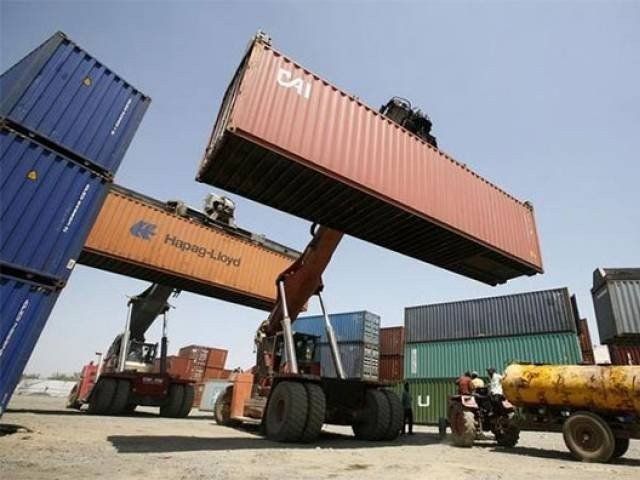
KARACHI: One of the most daunting challenges, faced by the current government, is to reduce the trade deficit.
The trade deficit in FY2017-18 was $35.6 billion, the highest in the country’s history. Although Pakistan has recorded trade deficits throughout most of its history, the trade deficit today has a rippling effect on the current account, as sources of foreign inflows are insufficient.
Even though remittances have increased, they are inadequate to balance the current account. The trade deficit can only be reduced if the increase in exports outperforms the increase in imports. Due to the nature of products exported and imported by Pakistan, tackling the trade deficit has always been a challenge.
The figures released by the Pakistan Bureau of Statistics (PBS) for December 2018 were somewhat favourable as the trade deficit declined. Exports in December 2018 were 5.48% higher than in December 2017 while imports were 8.88% lower. The trade deficit in December 2018 was 18.6% lower than in December 2017.
The cumulative value of exports between July and December 2018 was 2.19% higher than the same period of previous fiscal year. Imports declined by 2.29% and the trade deficit fell by 5.07%. Even as the deficit is decreasing, a further examination of the trade pattern is necessary. All figures are reported in dollar terms. A major reason for the declining imports is that CPEC-related demand for power plant machinery has decreased in the current fiscal year.
According to statistics of import payments published by the State Bank of Pakistan (time lag in payments is one of the reasons for the difference between PBS and SBP data), payments between July and November 2018 were higher than for the same period of previous year.
More than $845 million worth of power-generating machinery was imported between July and November in FY17. Imports in FY18 were more than $1.57 billion. With the abatement of energy crisis, the demand for power-generating machinery is now lower. Imports fell to $290 million between July and November in the current fiscal year.
If the pattern continues and no major imports of power-generating machinery occur in the next few months, Pakistan is likely to save a significant amount. Other products showing a lower value for imports are food products and transportation equipment. However, the extent of savings is smaller than that reported for the power-generating machinery.
On the other hand, imports of raw cotton, synthetic fibre, fertilisers and plastic material increased in recent months. Moreover, imports of crude oil and LNG between July and November 2018 were $1.53 billion more than the imports reported in the same period of preceding year. In essence, the composition of imports has shifted from machinery to petroleum products.
Export growth
Although the shift in import composition is likely to be influenced by several external factors, such as global oil prices, it is essential that the government prioritises export growth to alleviate concerns over the trade deficit.
Exports of certain products, such as textile and food products, are likely to increase in FY19. Although the overall increase in total export receipts reported by the SBP between July and November 2018 over the same period of previous year is negligible, the receipts for textile products have increased by approximately 5% and food products by 7%.
Knitwear is the biggest beneficiary as its exports have increased by more than 13%, an absolute increase of over $146 million. On the other hand, exports of other manufactures have decreased. Exports of leather manufactures, sports goods and manufactured fertiliser fell between July and November 2018 compared to the same period of previous year.
The economic conditions and incentives, which have helped exports of traditional products, such as textile and food products, have not translated into higher export growth for non-traditional products.
Export receipts from traditional markets such as the US, UK, UAE and China were higher between July and November 2018 compared to the corresponding period of last year. Similarly, receipts from Indonesia increased by more than 100%. On the other hand, regional trade was lower.
Regional trade
According to latest findings of the World Bank on regional trade in South Asia titled “A Glass Half Full: The Promise of Regional Trade in South Asia”, the cost to trade between South Asian countries is higher than the cost of trade with Latin American countries.
The average trade cost for the country pairs in South Asia is 20% greater than between country pairs in East Asia. Furthermore, the presence of tariff and non-tariff barriers, along with extensive presence of sensitive lists which limit the concessions on tariffs, inhibit the flow of intra-regional trade.
The current government has taken initiatives to reduce the cost of doing business. For instance, the plan to open ease of doing business offices across the country will help, if they are empowered to remove the bureaucratic bottlenecks faced by the exporters.
The government must also implement single-window facilities and take paperless trade initiatives which allow businesses to effectively participate in trade activities. Pakistan has ranked poorly in the indicator of ‘trading across borders’, a sub-group of the Doing Business Indicator, published by the World Bank. It is imperative that the trading costs are lowered to sustain export growth.
Moreover, the government must ensure that all tariffs are rationalised, such that they promote trade rather than discourage it. Higher import tariffs on finished products that increase mark-up for domestic producers may instead reduce exports.
‘Make in Pakistan’ must focus on increasing the competitiveness of Pakistani producers in the global rather than domestic market.
The writer is the Assistant Professor of Economics and Research Fellow at CBER, IBA
Published in The Express Tribune, January 21st, 2019.
Like Business on Facebook, follow @TribuneBiz on Twitter to stay informed and join in the conversation.































































COMMENTS
Comments are moderated and generally will be posted if they are on-topic and not abusive.
For more information, please see our Comments FAQ